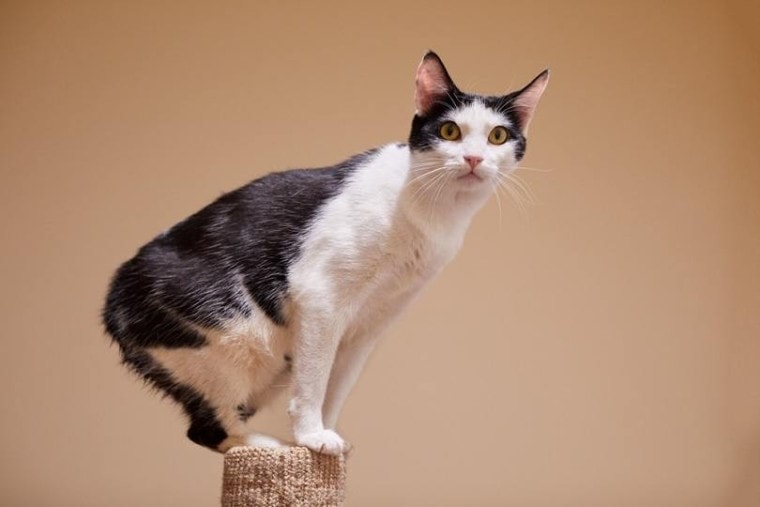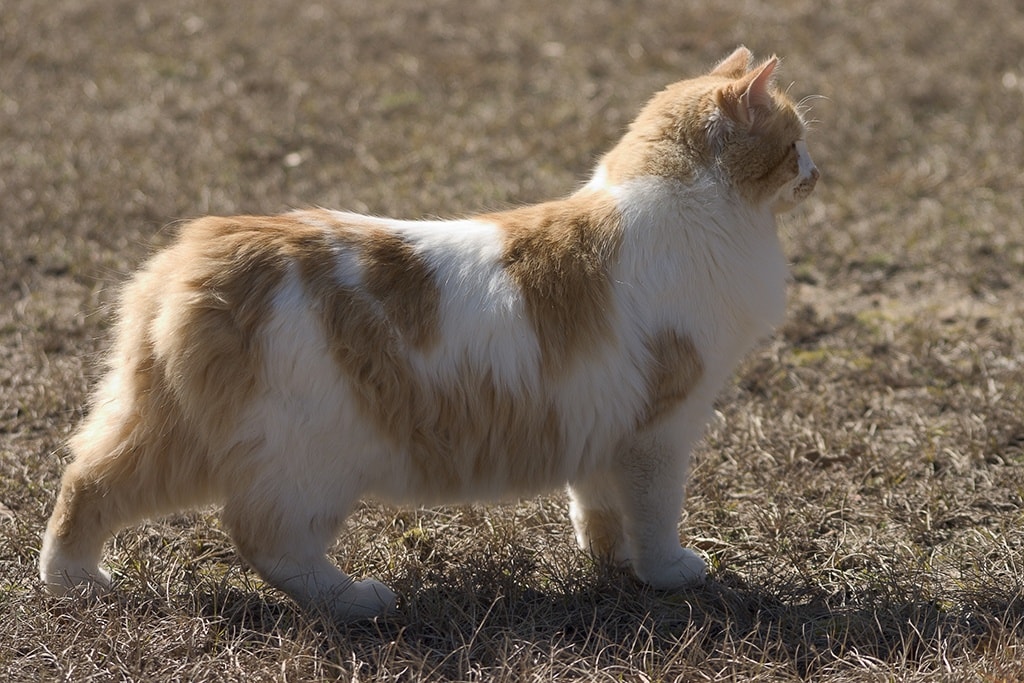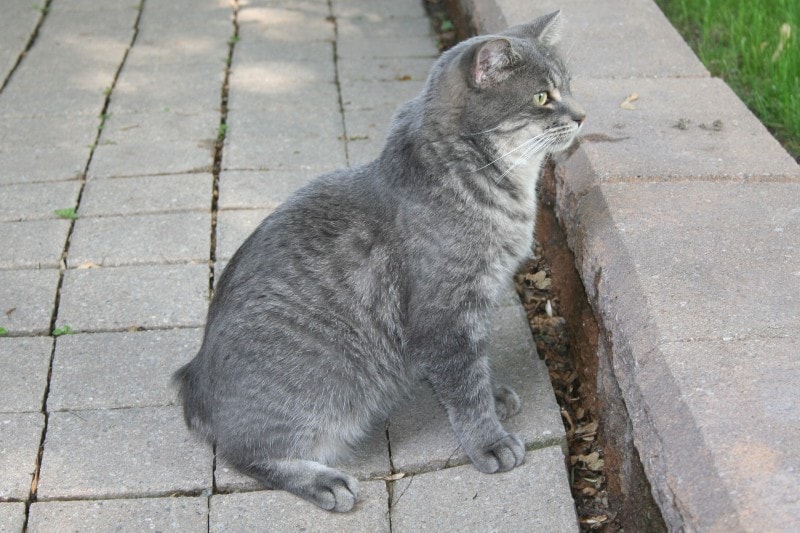
Click Below to Skip Ahead
The Manx cat is a crossbreed between the Himalayan, Persian, and other long-furred cat breeds. The Manx has no properly developed tail, and it instead looks like a stump. Other distinguishable characteristics are the elongated hind legs and rounded head. The first known breed standard was published in 1903, and the Manx cat breed has been exhibited in cat shows for its unique appearance since the 1800s. The tailless feature of the Manx is due to a naturally occurring genetic mutation that shortens the tail.
Breed Overview
Height:
7 – 11 inches
Weight:
8 – 12 pounds
Lifespan:
10 – 15 years
Colors:
Black, white, blue, orange, gray, beige, tan, brown, sable
Suitable for:
Families with children and other cats
Temperament:
Affectionate, social, and inquisitive
This cat breed has been dominant in Britain’s Isle of Man for centuries. The Manx cat has been well-loved for its tame, active, and social temperament which attracts many cat owners beyond their appearance.
Manx Cat Characteristics
Manx Kittens
The ebony-white Manx is rare to find, and they will understandably cost more than your average Manx kitten. Manx cat prices are generally inexpensive and can be found at a shelter, pet stores, and through reputable breeders. High-quality Manx kittens, usually those that have no tail and only a stump protruding will cost more.

Temperament & Intelligence of the Manx Cat
Are These Cats Good for Families? 👪
The Manx cat breed is quite good for children and adults alike. They are highly intelligent and social and have been known to get along well with young children. The Manx is also gentle enough to live with senior owners as their activity levels are undemanding and it is easy to care for them. Their lack of tails makes balancing difficult, so you may consider this cat breed if you do not want an agile cat.
A bonus to this breed is that they have no tail that babies and toddlers could grip and pull on. This may be a good cat breed for families who struggle with children who like to pull pets tails.
Does This Breed Get Along with Other Pets?
Manx cats can get along with other peaceful cat breeds as well as large senior dogs that are well-tempered. A puppy or boisterous dog can bother your Manx cat and cause them to lash out or become withdrawn. This cat breed enjoys a peaceful environment where they can spend time with their owner or do their own thing around the house.
Things to Know When Owning a Manx Cat:
Food & Diet Requirements 
The Manx cat breed has no special dietary requirements. Like most cats, they require a balanced diet of protein, carbohydrates, fiber, and vitamins. It is recommended that their food contains fish oils and omega 3 fatty acids. This helps to keep their coat healthy and shiny. Taurine is a good additive as it aids in vision and heart health. Fiber is essential for digestion control, while protein is good for energy maintenance and vitality.
Ensuring that your Manx has a good diet is essential for their health and well-being. A healthy diet can help fight off deficiencies and conditions caused by poor nutrition. Well-rounded cat food can provide your Manx with all the nutrients and minerals they need, so pay attention to the ingredients each cat food has to offer.

Exercise 🐈
Manx cats are not overly energetic, but they sure do love to play. Playtime helps to enrich their lives and provides them with mental stimulation to keep their brains active. You can provide this cat breed with toys, cat-friendly games, and supervised outdoor time.
Keep in mind that they lack a primary feline balance limb, their tail. This makes them less agile than other cats. Although this factor may be beneficial to owners who do not want a cat who loves to climb, it can be dangerous if they do decide to climb high places. If the Manx falls, they may injure themselves during landing. Another downside is that your Manx may struggle to get back onto the property if they were to jump over a wall or fence.
The Manx cat breed also loves to spend time with its owner. You can even use handheld cat toys to encourage them to chase and play around which is a perfect way to provide your Manx with some much-needed exercise and companionship.
Training 🧶
This cat breed can be easily trained to use the litter box. This can help to limit the number of accidents around the house. Although they will not use a dirty litter box or one that multiple different cats use. They can be fussy at times; however, they are considered easy to please when compared to other breeds of cats. Once the Manx is out of their playful kitten stage, they will calm down and become easier to handle in a household. The Manx enjoys the consistency of routine. This includes making feeding roughly the same time each day. Avoid making major changes to your cat’s routine as it can cause them unnecessary stress.

Grooming ✂️
Sticking to a grooming and hygiene schedule can help keep your Manx cat’s coat in good condition. They will typically groom themselves, which is one of the most beneficial ways that they keep themselves clean. Like most cats, the Manx does not require a complicated grooming routine, and washing them should only be done a few times a year. Over-washing your Manx can remove natural oils that they use to protect their fur and skin.
The Manx comes in every coat color imaginable, and each coat has a similar hygiene routine except for cream or white. White fur gets dirty more easily and can appear brown around the mouth and eyes. A pet-safe eye wipe can be used to remove the discolored gunk and dried food from their mouth with ease.
A grooming parlor will be able to give your Manx a good wash now and then. The most important part of grooming this cat breed is to ensure that their nails are kept at a comfortable length. A vet or groomer can cut your cat’s nails every few weeks to ensure that they do not grow into the paw pad which can be painful and discourage your cat from doing daily activities.
Health and Conditions 🏥
 Male vs Female
Male vs Female
It is quite difficult to tell the difference between a male and a female Manx cat. Both genders are a similar weight depending on their genetic history of obesity and dietary choices. One defined way to tell the difference between a male and female Manx is to look at the genital area. You will be able to see nipples on the female if you gently move the fur. Her genitals will be closely tucked near her anus whereas the males will be further apart and more defined. In some cases, the female will be a few inches taller than the male which makes them appear larger.
3 Little-Known Facts About the Manx Cat
1. It was believed that the Manx was a mix between a rabbit and a cat.
This is false and stemmed from a false belief that cannot be scientifically proven. There is no record of successful breeding between a rabbit and cat.
2. The Manx cat lacks a tail
This occurs through a genetic mutation and only a slight stump may remain where the tail is supposed to be.
3. All-white Manx cats are difficult to find
It is rare to find an ebony white Manx cat that has no other colors mixed in. They will cost more, and a breeder is most likely to sell them.

Final Thoughts
The Manx cat breed can make an interesting addition to your life. Not only do they have a unique and distinctive tailless body, but they also have wonderful personalities. The Manx is easy to train and generally undemanding in terms of care. They have no special dietary requirements and grooming is fairly straightforward. The only thing you should be on the lookout for is any balance issues or urination and defecation problems that are a result of their spinal deformity.
Overall, this is a great cat breed that is eager to please its owner. We hope that this article has helped inform you of the care requirements for this fascinating cat breed.
Featured Image Credit: Seattle Cat Photo, Shutterstock


 Male vs Female
Male vs Female



